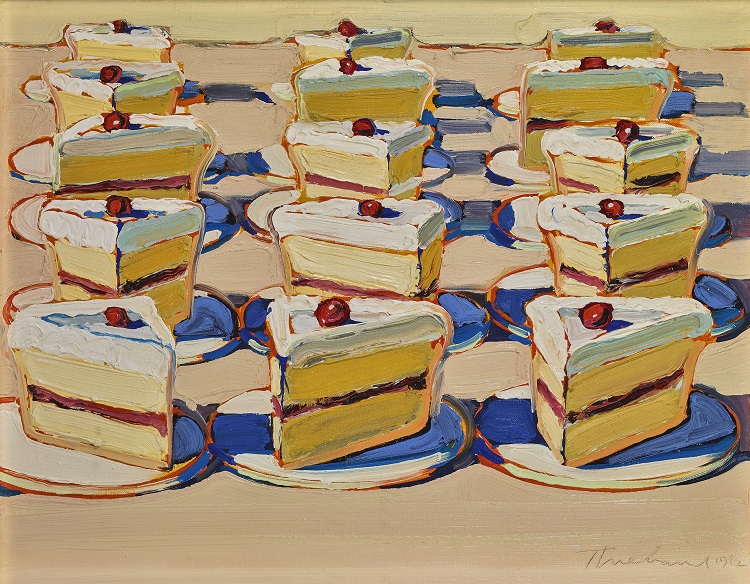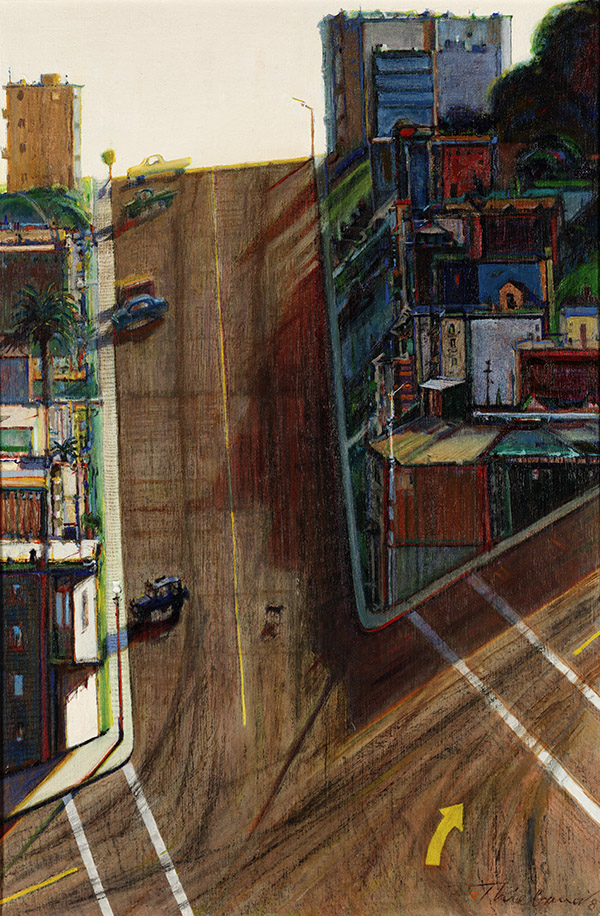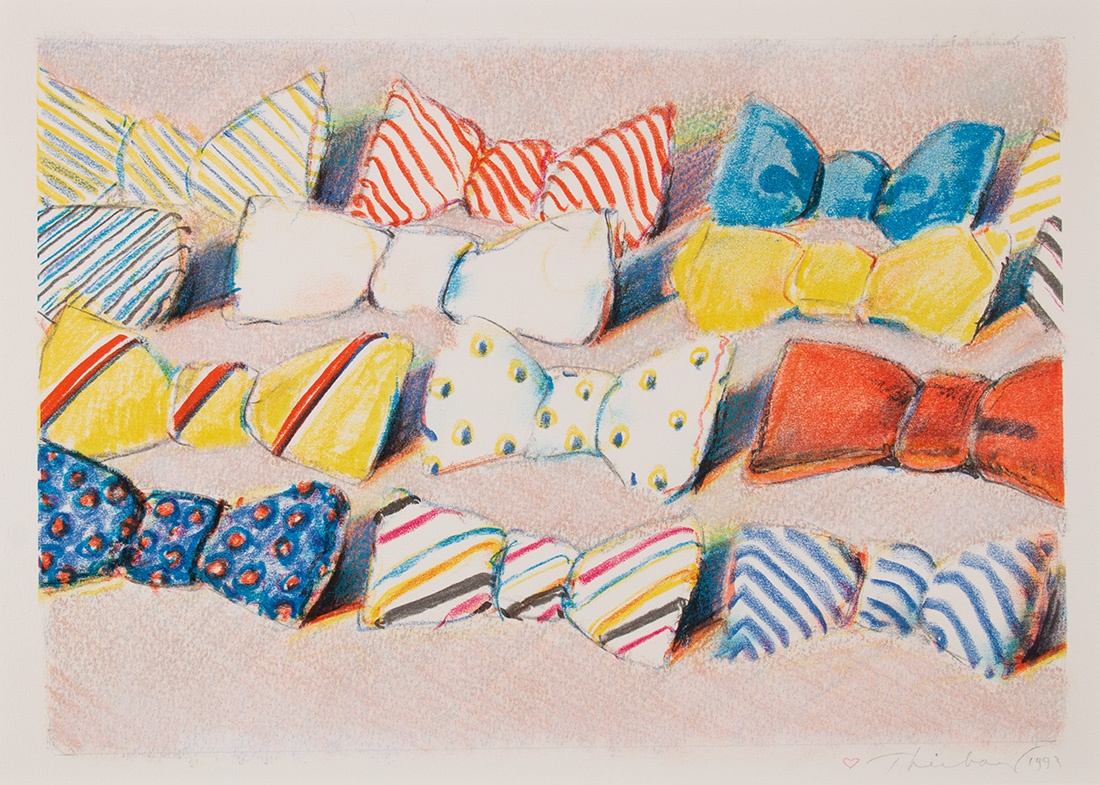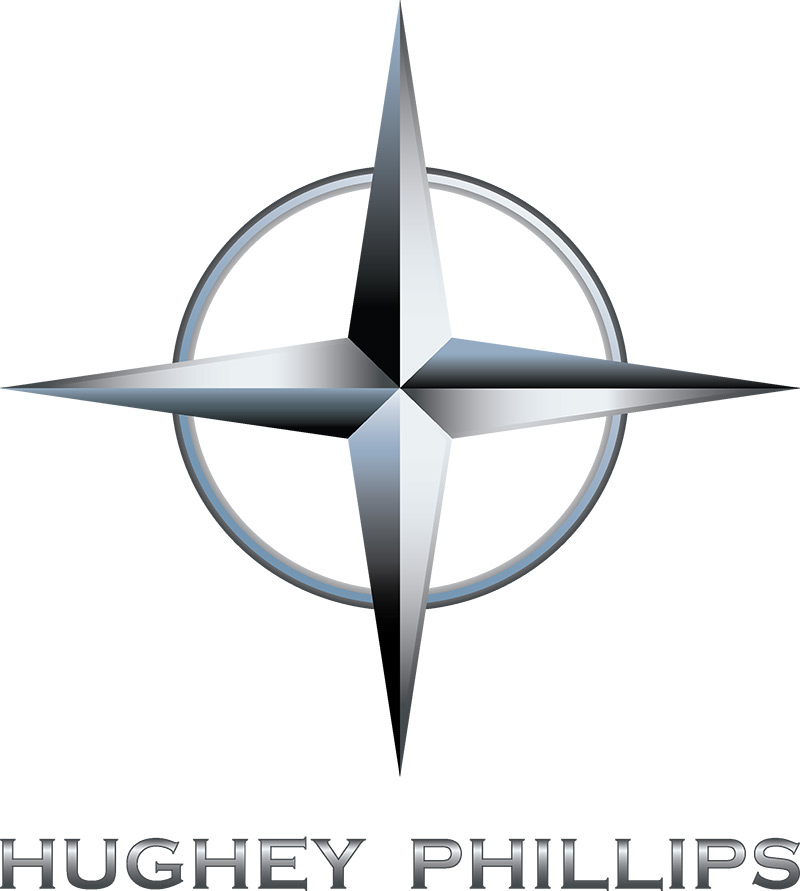Wayne Thiebaud 100: Paintings, Prints, and Drawings celebrates the 100th birthday of Sacramento’s most renowned artist through 100 works. Best known for his tantalizing paintings of desserts, Thiebaud has long been affiliated with Pop Art, though his range is far more expansive. This exhibition represents the artist’s achievements in all media and through a broad array of subjects, with pieces drawn from the Crocker’s holdings and the collections of the Thiebaud Family and Foundation — many of which, until now, have not been shown publicly. For the Crocker, the show continues a tradition of hosting a Thiebaud exhibition every decade since 1951, when the Museum held the artist’s first one-person show, Influences on a Young Painter—Wayne Thiebaud, an exhibition that, like the current exhibition, included paintings, prints, and drawings.
Thiebaud’s art has long been beloved in Sacramento, and today this is the case among audiences internationally. Born November 15, 1920, in Mesa, Arizona, Thiebaud spent most of his childhood in Long Beach, California, and, for a time, in southern Utah. He came to know the Sacramento region in 1942 while stationed at Mather Field (now Mather Air Force Base) with the United States Army Air Forces. In 1950, he began attending Sacramento State College (today California State University, Sacramento) and while pursuing his Master’s degree there started teaching at Sacramento Junior College (now Sacramento City College). “Sacramento,” he acknowledges, “gave me something essential.” Local shop windows, the California State Fair, neighborhood bakeries and delis, community members, and river landscapes have all factored into his art.

Wayne Thiebaud, Boston Cremes, 1962. Oil on canvas, 14 x 18 in. Crocker Art Museum Purchase, 1964.22. © 2020 Wayne Thiebaud / Licensed by VAGA at Artists Rights Society (ARS), NY.
In 1960, Thiebaud began teaching at the University of California, Davis. Two years later, he gained widespread recognition for his still lifes of food and commonplace objects through the success of his exhibition at the Allan Stone Gallery in New York. He subsequently began rendering the people he knew and then turned to depicting the landscape. The latter led to his series of urban San Francisco views, and, subsequently, rural Sacramento–San Joaquin Delta scenes. All the while, he has continued to explore the food subjects that made him famous.
Based in observation and convincingly executed, Thiebaud’s art looks real and often feels comfortingly familiar, qualities that have led most viewers to describe it as realist. At the same time, extended looking evidences its unreality, as the artist filters his subjects through his memory, knowledge of art history, and imagination. Only in his sketches and, to a certain degree, his representations of the human form, does Thiebaud directly record what’s at hand. Most of his finished works are manipulations of reality, capturing what he knows or feels about an object or place, not just its appearance.
Nearly everything Thiebaud depicts is either man-made, mass-produced, or somehow manipulated. This human- centered combination of reality and artifice is integral to Thiebaud’s work. In terms of his still lifes, food is rarely straight from the garden (or orchard) but is processed and often laid out cafeteria-style, in orderly rows and display cases. He also frequently showcases a single type of food, such as pie or ice cream, a departure from the random assemblies of disparate objects so often depicted in the still lifes of art-historical tradition. Thiebaud’s landscapes also demonstrate human manipulation, which he then transforms still further. This is certainly the case with his city scenes, which he conceives through an assembly of sketches that he combines into fully realized paintings and prints with dizzying results. Even in Thiebaud’s less trammeled landscapes, where human intervention is not so apparent, the implied presence of people remains critical to the work. “If that implication isn’t there,” he explains, “there’s something uninhabitable about the picture.”

Wayne Thiebaud, Street and Shadow, 1982–1983/1996. Oil on linen, 35 3/4 x 23 3/4 in. Crocker Art Museum, gift of the Artist's family, 1996.3. © 2020 Wayne Thiebaud / Licensed by VAGA at Artists Rights Society (ARS), NY.
The same is even true for Thiebaud’s renderings of people themselves, though they generally remain closer to their original source, as he most often works from models, including friends and family. He nevertheless portrays people as having been shaped by their time and place: hairstyles and clothing are emblematic of their era; faces suggest a familiar weariness associated with modern life; and poses frequently connote isolation, even in groups. Most recently, Thiebaud has been portraying people as circus clowns.
In all the genres in which Thiebaud works, he is concerned with formal artistic problems and conveying the properties of light. The harsh scrutiny of manufactured, fluorescent light is certainly emblematic of his art, as are his well-known rainbow halations of color that he perceives under strong illumination and uses to enliven the edges of his subjects and transition them into their stark backgrounds. Thiebaud’s abundant use of white also helps to create the perception that his paintings emit their own light. New Yorker writer Adam Gopnik describes the light in Thiebaud’s paintings as manifesting “the sudden glare” of the West Coast, “just after you take off your sunglasses.”
Also setting Thiebaud’s work apart from that of many of his contemporaries (both early on and now) is his obvious esteem for his craft. During the Pop Art era, for instance, artists like Andy Warhol and Roy Lichtenstein relied on photomechanical methods of expression, which projected an air of impersonal detachment. Thiebaud’s art, by contrast, has always been labored over and loved, making it decidedly more personal and, by extension, inherently more optimistic. This does not imply that it fails to critique consumerism and the isolation one can feel even in a world of abundance. It does. And yet, Thiebaud’s undeniable reverence for the act of creation is also celebratory, validating the pleasures and foibles of our contemporary world as subjects worthy of our attention and of art.
Following its debut at the Crocker Art Museum, the exhibition will travel to the Toledo Museum of Art, Toledo, Ohio; the Dixon Gallery and Gardens, Memphis, Tennessee; the McNay Art Museum, San Antonio, Texas; and the Brandywine Conservancy & Museum of Art, Chadds Ford, Pennsylvania. The exhibition is accompanied by a 212-page catalogue published by Pomegranate Communications, Inc., with essays by Scott A. Shields, Margaretta Markle Lovell, Hearne Pardee, and Julia Friedman, along with a chronology by Mary Okin.

Wayne Thiebaud, Bow Ties, 1993. Color lithograph hand-worked with pastel, 9 7/8 x 13 5/8 in. (image), 15 x19 7/8 in. (sheet). Crocker Art Museum, gift of the Artist's family, 1995.9.38. © 2020 Wayne Thiebaud / Licensed by VAGA at Artists Rights Society (ARS), NY.
Top Image: Wayne Thiebaud, Betty Jean Thiebaud and Book, 1965–1969. Oil on canvas, 36 x 30 in. Crocker Art Museum, gift of Mr. and Mrs. Wayne Thiebaud, 1969.21. © 2020 Wayne Thiebaud/Licensed by VAGA at Artists Rights Society (ARS), NY.
About the Author: Scott A. Shields, Associate Director and Chief Curator at the Crocker Art Museum, holds an MA and PhD in art history from the University of Kansas. He has twenty-five years of museum experience in the Midwest and California. Having curated more than seventy-five exhibitions, he has been the primary or sole author of numerous exhibition catalogues, including Artists at Continent’s End: The Monterey Peninsula Art Colony, 1875–1907; Edgar Payne: The Scenic Journey; A Touch of Blue: Landscapes by Gregory Kondos; Armin Hansen: The Artful Voyage; David Ligare: California Classicist; E. Charlton Fortune: The Colorful Spirit; Richard Diebenkorn: Beginnings, 1942–1955; and Granville Redmond: The Eloquent Palette.
Thank You Sponsors!
Thank you to the following Wayne Thiebaud 100: Paintings, Prints, and Drawings exhibition sponsors, as well as the many other supporters whose generous contributions made the exhibition — and many related programs — possible: Title sponsor Marcy Friedman; presenting sponsor Hughey Phillips, LLP; signature sponsor Joyce and Jim Teel; supporting sponsor Murphy Austin Adams Schoenfeld LLP.




